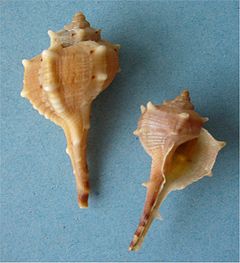Bolinus brandaris (originally called Murex brandaris by Linnaeus and also Haustellum brandaris), and commonly known as the purple dye murex or the spiny dye-murex, is a species of medium-sized predatory sea snail, an edible marine gastropod mollusk in the family Muricidae, the murex snails or the rock snails.[1]
| Bolinus brandaris ↓ | |
|---|---|

| |
| Two shells of the spiny dye-murex | |
| Scientific classification | |
| Domain: | Eukaryota |
| Kingdom: | Animalia |
| Phylum: | Mollusca |
| Class: | Gastropoda |
| Subclass: | Caenogastropoda |
| Order: | Neogastropoda |
| Family: | Muricidae |
| Genus: | Bolinus |
| Species: |
B. brandaris
|
| Binomial name | |
| Bolinus brandaris | |
This species is known in the fossil record from the Pliocene (age range: from 3.6 to 2.588 million years ago). Fossil shells of this species have been found in Cyprus, Spain and Italy.[2] It was used by the Phoenicians in ancient times to extract imperial Tyrian purple dye.[3]
This snail lives in the central and western parts of the Mediterranean Sea and has been found on isolated coral atoll beaches in the Indian Ocean and South China Sea. It was known since ancient times as a source for purple dye and also as a popular food source under various names, among which sconciglio, from which comes the word scungilli. This species lives on rocks in shallow water.
This species, like many other species in the family Muricidae, can produce a secretion which is milky and without color when fresh but which turns into a powerful and lasting dye when exposed to the air. This was the mollusc species used by the ancients to produce Tyrian purple fabric dye.
Sea snails of the species Banded dye-murex Hexaplex trunculus were also used to produce a purple-blue or indigo dye. In both cases, the mollusks secrete the dye in the mucus of their hypobranchial glands.
In Spain, and more specifically on the Mediterranean coast and the Gulf of Cádiz, they are called cañaílla, and are appreciated as food.
It is a cannibalistic species; evidence suggests that intensive breeding by the ancient Minoans resulted in pierced shells, perhaps by other snails, due to the population density in breeding tanks.
The size of the adult shell of Bolinus brandaris can reach about 60 to 90 mm. The shell is usually golden brown with a very long siphonal canal and a rounded body whorl with a low spire. There is a row of spines that corresponds to the end of each growth stage.
Infrasubspecific names are not recognized by ICZN.[citation needed]